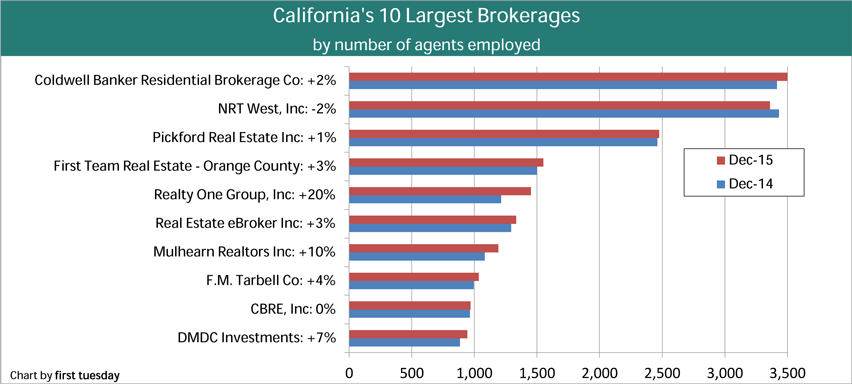Find out who excelled and who missed the list in this year’s compilation of the 60 largest brokerages in California.
*Chart does not include the number of broker-associates employed, only sales agents employed by each broker.
This Market Chart is an annual feature, compiled and presented by first tuesday.
This chart shows the percentage change in the number of licensed agents employed by California’s 60 largest brokerages from December 2014 to December 2015. Take a moment to see how these large brokers are faring in today’s economic expansion. What costs might brokers be cutting and what aspects of their practice are they investing in? Who among these brokers will go on to continued success?
Most of the state’s major brokers experienced only marginal changes in employment over the past year. Some, like Realty One Group, continued to add significant numbers. Others, like San Diego Homes and Estates, are new to this list. Other brokerages have fallen off. For instance, missing from this year’s list are Cushman & Wakefield Of California, CTO Realty Inc and TRG Realestate Group Inc.
Employment finally caught up to pre-recession numbers in California at the end of 2014, a process which took seven years. However, the jobs recovery continues in 2016, as the intervening population gain of 1.2 million working-aged individuals means we won’t likely see a real jobs recovery until 2019.
Few industries suffered in the recession as much as those related to real estate. Licensees who remain full-time real estate service providers today are the ones who have successfully adjusted with a bit of talent and perseverance. Going forward, the main concern for sales agents and brokers in 2016 will be the continued low home sales volume due to suppressed demand from buyer-occupants coupled with below-average inventory.
The largest 10 – how do they do it?
This second chart depicts the very largest of the large: the ten brokerages employing the most agents in California as of December 2015.
It was a mixed year for these exceptionally large brokerages, with a majority increasing their number of agents employed. These ten brokerages collectively added 567 agents, while 2,512 were added to the top 60. The California Bureau of Real Estate (CalBRE) reports real estate agent licensing is down significantly from the boom years preceding 2008, meaning there are now simply fewer agents to go around.
Brokers who once profited by flooding the market with agents to capture sales and mortgage transactions are taking advantage of the extended housing recovery to streamline their operations. Focused and better qualified agents are needed for today’s more targeted and refined client service operations.
The majority of the ten largest brokerages focus their business in single family residential (SFR) sales. CBRE, Inc is the only top-ten brokerage to focus on commercial real estate. Notably, all top ten brokers are located in or near urban areas — namely Los Angeles, San Francisco and San Diego. Brokerages located in cities are poised for growth in 2016 and the future, as more households make their living in these areas each year.
Other things the top ten are doing right:
1. Diversified brokerage services. While large brokerages undoubtedly have the advantage when it comes to real estate services, smaller brokerages can also benefit from branching out. This provides a buffer when one niche in the market is on a downswing. For example, F.M. Tarbell (tarbell.com) also provides relocation services and property and casualty insurance services.
2. Client contact. Many of these brokerages have built-in systems to reinforce client contact. For instance, First Team Real Estate (firstteam.com) offers numerous tools accessible by clients, including market trends and articles on real estate. Staying informed about the housing market shows potential clients that you are an industry expert.
3. Tech savvy. Coming in at number six, Real Estate eBroker Inc (REeBroker.com) is the sole online-based brokerage to make the list. This non-traditional format is working for RE eBroker, as it remains one of the few large brokerages continuing to grow each year during this housing recovery. Their business model is centered around the belief that the real estate industry is moving away from face-to-face contact and toward technology-based transactions. They offer services such as free agent websites, transaction coordinator services and an online library of commonly used forms and other agent documents.
4. Extended training and staff support. Successful brokers support their sales agents by offering training for both new and experienced agents. Training agents in a range of transactions (such as non-SFR sales and investor transactions) is not only helpful for new agents, but allows more experienced agents to broaden their client base. Sotheby’s International Realty (sothebysrealty.com) advertises for specialty markets their agents are trained to handle, including ranches, waterfront properties and vineyards.
Who is behind the mask?
Is the list missing a large brokerage you think should be recognized? Keep in mind that certain big names, such as Century 21 and Re/Max are not operations of a single brokerage but real estate franchise arrangements used by several different employing brokers to exploit brand name recognition.
Franchisors contract with numerous individual brokers who operate separately from the franchisor and employ agents (and other brokers). On this chart, franchises are distinguished from their independently branded corporations who employ agents under one corporate broker’s license. Several of the brokerages on the list operate as franchisees under separate “doing business as” names (DBAs), such as Century 21, Coldwell Banker and Re/Max.
Maybe, on the other hand, you are having trouble recognizing some of the names on the charts above. In fact, they may be more familiar than you think, but operating under separate DBAs.
For the DBAs of each of these 60 brokers, see the chart below.
 Finally, the fourth chart shows the total number, as opposed to percentage growth, of licensed agents employed by each of the largest 60 brokers. This chart is indexed by the total number of agents employed as of December 2015.
Finally, the fourth chart shows the total number, as opposed to percentage growth, of licensed agents employed by each of the largest 60 brokers. This chart is indexed by the total number of agents employed as of December 2015.


















Numbers of agents does not represent a valid picture of the most successful brokerages. Gross Commission Income or Sales Volume is a much better means of measuring a real estate brokerage.
The days of “people processing”, simply taking any licensee that is still breathing, are over. The business is far too technical and litigious for most licensees to actually perform to the professional level required in todays real estate environment.
The future of real estate looks like more business being consolidated into fewer and fewer agents and brokerages. The most successful sales organizations will involve teams and partnerships of highly competent agents. It’s no longer about sheer agent numbers.
How about Prudential Realty, Berkshire?
Thank you for your inquiry. A few brokerages on the list operate under Berkshire and Prudential DBAs, such as Mulhearn Realtors and Pearson Properties.